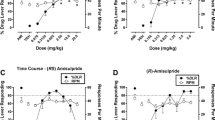Abstract
Rationale: Analysis of the preclinical behavioral effects of atypical antipsychotic agents will provide a better understanding of how they differ from typical antipsychotics and aid in the development of future atypical antipsychotic drugs. Objectives: The present study was designed to provide information about the discriminative stimulus properties of the atypical antipsychotic olanzapine. Methods: Rats were trained to discriminate the atypical antipsychotic olanzapine (either 0.5 mg/kg OLZ or 0.25 mg/kg OLZ, i.p.) from vehicle in a two- lever drug discrimination procedure. The atypical antipsychotic clozapine fully substituted for olanzapine in both the 0.5-mg/kg OLZ group (99.3% drug lever responding [DLR]) and the 0.25-mg/kg OLZ group (99.9% DLR). The typical antipsychotic chlorpromazine also substituted for olanzapine in both the 0.5-mg/kg OLZ group (87.5% DLR) and in the 0.25-mg/kg OLZ group (98.9% DLR); whereas, haloperidol displayed partial substitution for olanzapine in the 0.5-mg/kg OLZ group (56.1% DLR) and in the 0.25-mg/kg OLZ group (76.4% DLR). The 5.0-mg/kg dose of thioridazine produced olanzapine-appropriate responding in the 0.5-mg/kg OLZ group (99.6% DLR), but only partial substitution was seen with the 0.25-mg/kg OLZ training dose (64.0% DLR). The atypical antipsychotics raclopride (53.9% DLR) and risperidone (60.1% DLR) displayed only partial substitution in the 0.5-mg/kg OLZ group. Both the muscarinic cholinergic antagonist scopolamine (90.0% DLR) and the 5-HT2A/2C serotonergic antagonist ritanserin (86.0% DLR) fully substituted for olanzapine in the 0.5-mg/kg OLZ group. Conclusions: In contrast to previous discrimination studies with clozapine-trained rats, the typical antipsychotic agents chlorpromazine and thioridazine and the serotonin antagonist ritanserin substituted for olanzapine. These results demonstrate that there are differences in the mechanisms underlying the discriminative stimulus properties of clozapine and olanzapine. Specifically, olanzapine’s discriminative stimulus properties appear to be meditated in part by both cholinergic and serotonergic mechanisms.
Similar content being viewed by others
Author information
Authors and Affiliations
Additional information
Received: 1 March 1999 / Final version: 6 September 1999
Rights and permissions
About this article
Cite this article
Porter, J., McCallum, S., Varvel, S. et al. The discriminative stimulus properties of the atypical antipsychotic olanzapine in rats. Psychopharmacology 148, 224–233 (2000). https://doi.org/10.1007/s002130050046
Issue Date:
DOI: https://doi.org/10.1007/s002130050046



